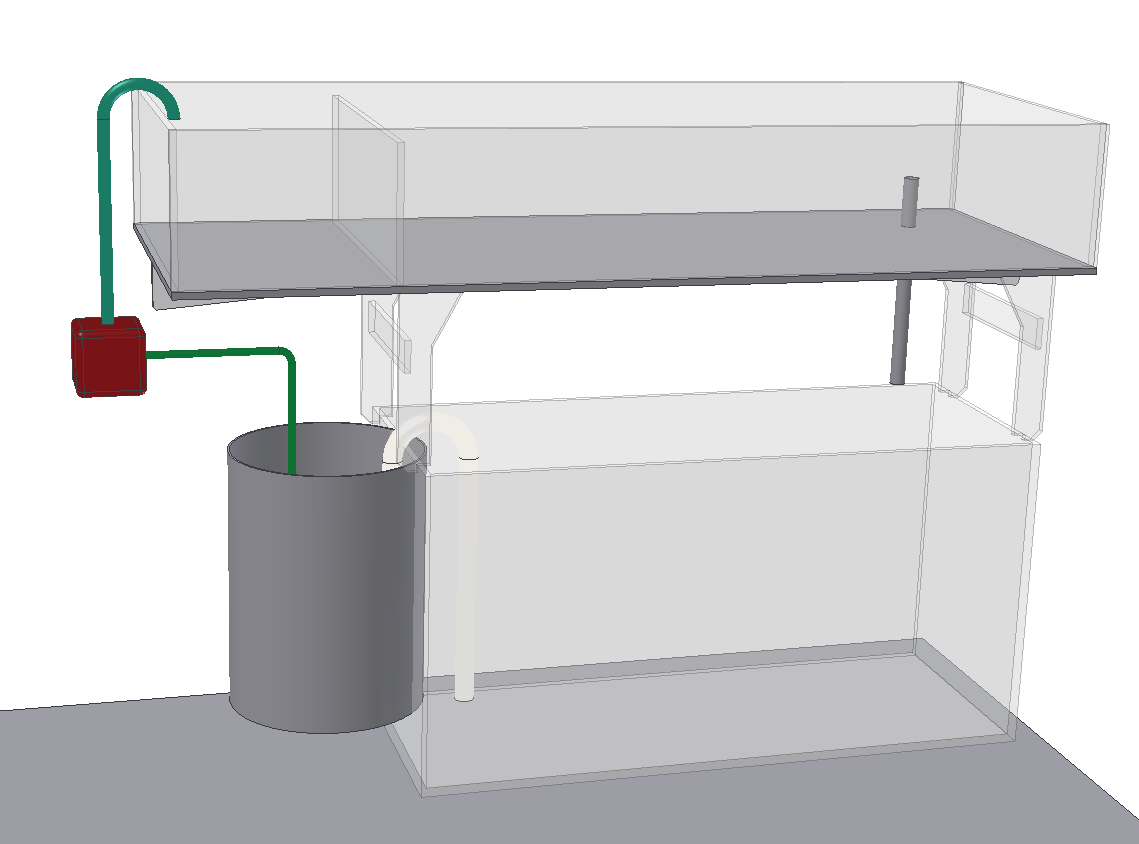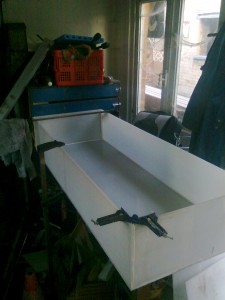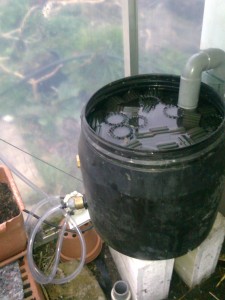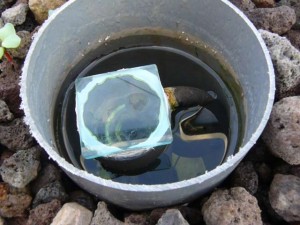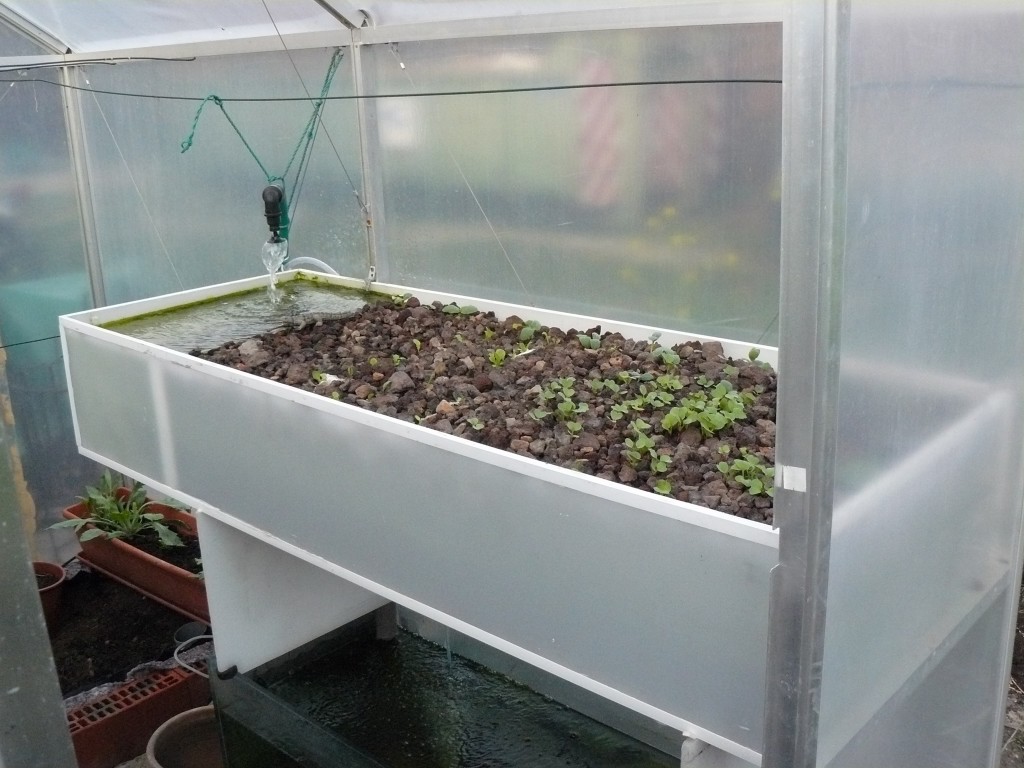eigen systeem 2011own system 2011
Het begon ergens in februari 2011, toen Tim (collega van Valentijn) kwam aandraven met een ‘nieuw project’: hij ging kruiden kweken op vissenstr…
Aangezien de lente aan’t kriebelen was en Lotte’s serre zo stilletjes aan in orde kon gebracht worden voor het nieuwe seizoen, smeedden we algauw wat plannen.
De doelen waren eenvoudig: met zo weinig mogelijk kosten een goed aquaponic systeem bouwen. We willen vis kweken én planten, en dit op een ecologisch manier.
Zo maakten we ons ‘eerste’ systeem in 2011:
De vistank was geen probleem: in de garage stond nog een oud 250l aquarium.
De plantenbak werd in 3D ontworpen:
De bak werd opgebouwd uit 10mm dikke kunststofplaten, een ‘overschotje’ van een lichttafel van een oude microfilm camera. Na wat uurtjes zaag-en lijmwerk was de bak klaar.
We willen ook zoetwaterkreeften kweken, en die beesten zitten graag in snel opwarmend water, dus maakten we in de plantenbak een deel vrij voor de schaaldierenfamilie.
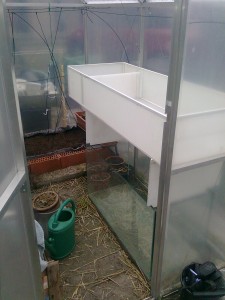 |
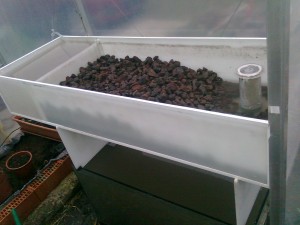 |
We verpompen het water niet rechtstreeks naar de planten maar via een buffertank. Hierdoor fluctueert het waterpeil in het aquarium minder en kunnen we nog wat grof vuil filteren. Bovendien is zo’n ’tussentank’ ideaal voor de bacteriën.
De plantenbak zelf wordt gevuld met lava. Dit kan ook met kleikorrels, maar daar staan de planten niet zo vast in. Veelal wordt ook gewoon grind gebruikt.
Wij kiezen voor lava omdat we er nog over hebben van de vijver :-). Bovendien heeft lava een zeer groot en ruw contactoppervlak waardoor het beter water vast houdt en de bacteriën beter kunnen werken.
In het aquarium willen we graag een inheemse eetbare vis kweken. We denken aan baars, voorn of iets dergelijks. Goudvis ziet Lotte niet zitten: “dat kunnen we niet opeten…”.
Tilapia (een cyclide-soort) wordt veel gebruikt omdat ie gemakkelijk te kweken is, weinig onderhoud vraagt, snel groeit en lekker is. Eén nadeel: de vis moet min.20°C hebben, en dat zien we in ons Belgen-landje niet zitten.
Heel belangrijk in een aquaponic systeem is de toevoer van zuurstof.
Niet alleen de vissen hebben genoeg zuurstof nodig, maar ook de planten. Maar het zijn vooral de ‘aerobe’ bacterieën die chloor en andere schadelijke stoffen omzetten in de broodnodige nitraten en nitriten.
In een goed evenwichtig systeem krijgen de anaerobe bacteriën weinig kans.
We zorgen ervoor dat de waterinlaat van de plantenbak veel zuurstof mee trekt, en ook de terugvoer naar de vistank stopt boven het waterniveau om veel lucht in het water te krijgen.
Voor alle zekerheid plaatsten we ook een extra luchtpomp. Het verbruik hiervan is gering (4W), dus we maken ons geen zorgen over de ecologische balans.
Eén van de leukste systemen is gebouwd om de plantenwortels van zuurstof te voorzien. De meeste planten hebben er een hekel aan om altijd in het water te staan. Met sla lukt het nog net.
Dit systeem heet een ‘auto-sifon’:
Het water stijgt rustig in de plantenbak tot aan het niveau van de overloop. Het overlopend water vormt een ‘waterslot’ dat de rest van de lucht mee trekt en zo een gesloten overloop vormt (communicerende vaten). Het water van de plantenbak trekt zo snel leeg waardoor de wortels zuurstof krijgen. Eens het waterniveau in het waterslot gezakt is tot de instroomopeningen, verbreekt de binnengezogen lucht de sifon. Een dun buisje zorgt ervoor dat het slot echt verbroken wordt, en alles begint opnieuw. Onze bak trekt ongeveer elke 15min leeg.
Het duurde even voor dit systeem op punt stond, maar nu werkt het perfect!
It started in February 2011, when Tim (Valentines colleague) came trotting with a new project “: He wanted to grow herbs on fish sh…
As spring starts itching, and Lotte’s green house could be cleaned up before the new season, we hatched some plans soon.
The goals were simple: to build a good aquaponic system with minimal cost. We want to grow fish and plants, in an ecological way.
2011 : The old Aquaponics System
So we made our “first’ system in 2011:
The fish tank was not a problem: We had an old aquarium of 250l in the garage.
The plant container was designed in 3D:
The tank was constructed from 10mm thick polyprop sheets, a stiffener on’ of a light table of an old microfilm camera. After some hours of cutting and gluing the container work was done.
We also want to breed lobster, and these animals are happy in fast water warming, so we made a division in the plant basin for the crustacean family.
 |
 |
We don’t pump the water directly to the plants but via a buffer tank. This makes sure the water level in the aquarium fluctuates less and works as dirt filter. Moreover, such ‘intermediate tank’ is ideal for the bacteria.
The grow bed itself is filled with lava. This can also be clay granules, but the plants are not fixed as well in it. Gravel is also often used.
We choose lava because we have remainings of the pond ![]() . In addition, lava has a big and rough contact surface assuring that the water is retained longer and the bacteria can work better.
. In addition, lava has a big and rough contact surface assuring that the water is retained longer and the bacteria can work better.
In the aquarium we would like indigenous edible fish cultivate. We think of perch, roach or something similar. Lotte does not like goldfish: “we can not eat it…”.
Tilapia (a-kind of cyclide) is widely used because he’s easy to grow, little maintenance, fast growing and delicious taste. A disadvantage: The fish must have a min. temp of 20 °C, which is not really possible in Belgium.
Very important in a system is the supply of aquaponic oxygen.
Not only the fish need enough oxygen, but also the plants. But mostly the ‘aerobic’ bacteria who convert chlorine and other harmful substances into nitrates and nitrites need it.
In a well balanced system the anaerobic bacteria get little chance.
We make sure that the water inlet of the plant container sucks a lot of oxygen, and the return to the fish tank stops above the water level to add a lot of air into the water.
To be sure, we also installed an additional air pump. The consumption of this is limited (4W), so we’re not worried about the ecological balance.
One of the best systems is built to apply oxygen to the roots of the plants. Most plants dislike to be always in the water. It can be done with lettuce.
This system is called an ‘auto-siphon’:
The water rises slowly in the plant basin up to the level of the overflow. The overflowing water forms a water seal’ pulling the rest of the air with it thus forming a closed overflow (communicating vessels). The water of the plant container is discharged fast so that the roots get oxygen. Once the water level in the siphon has dropped to the vent holes, air is sucked in and breaks the siphon. A thin tube ensures that the lock is actually broken, and everything starts all over again. Our container is filled about every 15 minutes.
It took a while to fine tune this system, but now it works perfectly!
